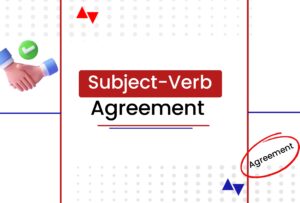Est. reading time: 4 minutes

In the English language, there’s always a subject-verb agreement in a sentence. This means a verb in a sentence must agree with the subject both in form and meaning. A verb in a sentence does not only show when an action is performed; it also indicates the number of subjects in the sentence.
In this article, we will explore the rules of subject-verb agreement while providing insightful explanations and practical examples of this essential aspect of grammar.
What is a subject-verb agreement?
Just like the phrase suggests, “subject-verb agreement” is the alignment or harmony between the subject and the verb within a sentence.
The subject-verb agreement is also known as the subject-verb concord and usually focuses on the nouns and pronouns that act as the subject in a sentence.
The verb in a sentence must be in agreement with the nouns and pronouns; it must align with the person, gender, and number of the subject. This implies that the majority of subject-verb agreement in the English language concerns quantity, i.e. when the subject is singular, the verb must be singular; when the subject is plural, the verb must be plural.
Additionally, subject-verb agreement extends to the tense, aspect, and mood of a sentence, ensuring that the verb matches the subject in these aspects as well.
What are the Rules of Subject-Verb Agreement?
To ensure that the subject of a sentence agrees with the verb of a sentence, you should follow certain rules.
Let’s go through some of these rules together and their examples to understand the subject-verb agreement better.
Rule 1: Singular/plural subject with a singular/plural Verb
Just like we mentioned earlier in the article, the subject should always be in alignment with the subject based on number, aspect, and time.
As regards number, the singular subject must go hand-in-hand with the singular verb and the plural subject with the plural verb.
While the subject can be a noun or pronoun, it is essential to know the number or quantity of the subject to accord them their suitable verbs.
Examples of a singular subject with a singular verb:
- My food tastes delicious.
- Goodness spends her break eating.
- The baby sleeps peacefully in the crib.
- My friend teaches English well.
Examples of a plural subject with a plural verb:
- Lots of people gather for the carnival.
- The ladies dance gracefully.
- The footballers train rigorously for their final match.
- The children play happily in the rain.
Rule 2: When there are multiple nouns joined by “and”, the subject should be seen as plural and the plural, verb form should be used
For instance:
- Bola and Tade are best friends.
- The teacher, parents, and students are having a meeting.
- The dog and child play together.
Rule 3: In a situation where the verb in a sentence is more than one, all the verbs in the sentence must agree with the subject, whether singular or plural.
This simply means that the major concern here is not the number of verbs but the number of nouns.
For example:
- The dogs chase the thief and bark loudly.
- The girl takes the toy and gives it to her mother.
Rule 4: In a sentence where two or more nouns or pronouns are connected by “or” or “nor,” the subject is considered singular, hence a singular verb is used.
Let’s see some examples:
- Neither Taiwo nor Kehinde wants to school.
- Coffee or tea, anyone is fine.
- Either a blue or pink dress is okay for the prom.
- Neither the baby nor the toddler wants to sleep.
Rule 5: When we talk of indefinite pronouns, we talk of pronouns that do not refer to a specific thing (person, quantity, or place). When an indefinite pronoun is used in a sentence, it is considered singular and takes the singular verb.
Examples include:
- Everyone loves ice cream.
- Nobody likes to be stressed.
- Every winner gets a thousand dollars each.
- Something smells fishy.
Rule 6: Relative pronouns like “who,” “that,” “which,” and “where” are commonly used in the English language. Relative pronouns, when used, determine whether the subject is singular or plural, which in turn dictates the verb form to be used.
Let’s check out these examples:
- The car that he buys is very nice.
- The girls who brought the gifts are outside.
Rule 7: There are sentences whereby a subject is a unit of measurement such as time, weight, distance, temperature, etc., and these units of measurement are considered to be singular, thus taking a singular verb.
- Twenty kilograms of meat is enough to feed everyone.
- Six yards of fabric is enough to make the dress.
Rule 8: Nouns that cannot be counted take a singular verb. This clearly explains why uncountable nouns (such as “water” or “information”) are paired with singular verbs.
Examples:
- Experience is needed when it comes to this field.
- The company produces different pharmaceutical products.
- Patience is key in teaching children.
Rule 9: We talked about relative nouns earlier in the article. We also have collective nouns. Collective nouns are groups of people, animals, or things as a single entity. Since they are regarded as a single entity, they are likewise treated as singular subjects; therefore, they take a singular verb.
- The team is practicing for the competition.
- The pride of the lion hunts for meat in the forest.
- My family enjoys spending time together.
Rule 10: In the English language, some nouns are naturally in the plural form and they have no singular variation. Examples are Glasses, shorts, scissors, etc.
Whenever you find nouns like this, the verb used is plural since they are already in a plural form.
For instance:
- Scissors are essential for sewing.
- Nowadays, glasses are worn for fashion.
Wrap Up!
To summarise this article, mastering subject-verb agreement is essential for clear and effective communication in the English language.
Always remember to match the subject with the appropriate verb in terms of number, person, and tense, as this will greatly enhance your knowledge of the English language.
With practice and attention to detail, achieving accurate subject-verb agreement will become easy for you.

